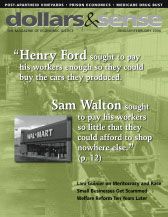
The Real Cost of Prisons Project
Economic analysis of the prison crisis reaches the grassroots.
This article is from the January/February 2006 issue of Dollars and Sense: The Magazine of Economic Justice available at http://www.dollarsandsense.org

This article is from the January/February 2006 issue of Dollars & Sense magazine.
Subscribe Now
at a 30% discount.
The people most directly affected by the prison crisis—prisoners, former prisoners, their family members and friends—know the human costs of mass incarceration first hand. They are the targets of the war on drugs, “tough-on-crime” policies, and the accompanying racism and sexism; they are part of the collateral damage of the economic and political forces that underlie the prison crisis. Any effective organizing to reverse the crisis should put their perspectives and experiences, and the understanding of the costs of mass incarceration these afford them, front and center.
But the people in the trenches may not have access to the best analyses of the economic and political forces shaping their lives and communities. The Real Cost of Prisons Project seeks to remedy this. With a series of comic books—one on the siting and financing of prisons, one on the drug war, one on the cost of prisons for women and children—the RCPP is bringing the results of academic research and organizing experience to the people most affected by mass incarceration.
“We love the RCPP!” said Maya Doe-Simkins, who runs Fuerza Latina in Dorchester, Mass., a group working to reduce drug-related harm in the Latino community there. (Fuerza Latina is affiliated with the acclaimed international organization Partners in Health and with Brigham and Women’s Hospital.) “The comic books are a wonderful example of the intersection of academic research and grassroots and community mobilization. The language is wonderfully accessible, and they are multi-layered, so that people can take the simple information or they can use them as a tool for deeper discussion.”

Marilyn Montenegro, a social worker in Los Angeles, has used “Prisoners of a Hard Life”—the comic that focuses on women and children—in A New Way of Life, a program for women leaving prison. “The women who have experienced imprisonment were able to relate to the experiences the comic books depicted—they provided a basis for discussion of the structural barriers that the women face. This is particularly important since in most contexts the women are encouraged to take personal responsibility for all that has happened to them and told that they had choices without anyone acknowledging that all the choices they had were bad ones!”
Other activists made the same point. “A lot of the agencies working most closely with people caught up in the criminal justice system aren’t necessarily helping them to understand the economic and political dimensions of their problems,” says Lynn Paltrow, executive director of National Advocates for Pregnant Women, which focuses on the intersection of drug and reproductive rights policies. “The RCPP comics help remedy this.” Paltrow also emphasized the wide range of people who can learn from them. She said that members of the South Carolina Women’s Health Coalition distributed “Prisoners of a Hard Life” at a women’s health fair. “Everyone from teenagers to older women of all races were picking them up. These are really reaching people who wouldn’t have access to this kind of analysis.”
Paltrow is also the lawyer for Regina McKnight, a North Carolina prisoner whose story is told in “Prisoners of a Hard Life.” Doe-Simkins reports that a young woman involved in a youth program in Dorchester was so inspired by the comic book that she ended up corresponding with McKnight.
Alan Clear, executive director of the Harm Reduction Coalition, reported similar success using “Prisoners of the War on Drugs” in a training program for people who work with drug users. “People can really relate to them, and they help people see that there are larger forces at work.”
How to Get the Comic Books
RCPP provides multiple copies free of charge to groups involved in organizing, community education and outreach work. Send a one-page letter or e-mail info--at--realcostofprisons.org. Include contact name, address, phone number, e-mail address, how many copies needed (up to 200), and a brief description of your organization or program and how the comic books would be used. Single copies for personal use can be purchased through AK Press or downloaded at www.realcostofprisons.org.
The comics are loosely based on a series of popular economics workshops developed by the RCPP, with funding from the Open Society Institute and support from staff economists. “We wanted them to be filled with complex ideas but easy to understand. They are written at a basic reading level, but filled with facts and information that are well documented,” the project’s director, Lois Ahrens, says.
Thousands of the comics have already been distributed, mostly to grassroots community groups, ranging from an alternative school in the South Bronx to family support groups in the deep South to programs providing books to prisoners themselves. “Our aim is to reach the people who are experiencing the greatest impact of mass incarceration and people who are organizing against it.” The information is even reaching some policymakers directly. Ahrens told of one activist testifying at the state legislature in Kansas who gave out copies of “Prison Town,” the comic on siting and financing of prisons; every legislator in the room was reading it. The reading level and comic-book format was key here, too, Ahrens suggested. “We’ve found that this is an appropriate medium for legislators, too.”
